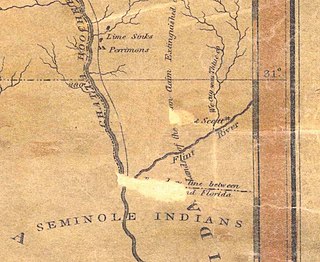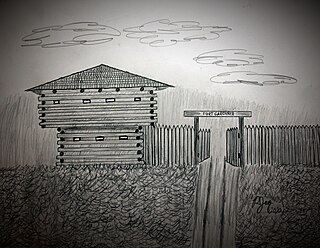Related Research Articles

The Seminole Wars were a series of three military conflicts between the United States and the Seminoles that took place in Florida between about 1816 and 1858. The Seminoles are a Native American nation which coalesced in northern Florida during the early 1700s, when the territory was still a Spanish colonial possession. Tensions grew between the Seminoles and American settlers in the newly independent United States in the early 1800s, mainly because enslaved people regularly fled from Georgia into Spanish Florida, prompting slaveowners to conduct slave raids across the border. A series of cross-border skirmishes escalated into the First Seminole War, when American General Andrew Jackson led an incursion into the territory over Spanish objections. Jackson's forces destroyed several Seminole, Mikasuki and Black Seminole towns, as well as captured Fort San Marcos and briefly occupied Pensacola before withdrawing in 1818. The U.S. and Spain soon negotiated the transfer of the territory with the Adams-Onis Treaty of 1819.

The Second Seminole War, also known as the Florida War, was a conflict from 1835 to 1842 in Florida between the United States and groups of people collectively known as Seminoles, consisting of Creek and Black Seminoles as well as other allied tribes. It was part of a series of conflicts called the Seminole Wars. The Second Seminole War, often referred to as the Seminole War, is regarded as "the longest and most costly of the Indian conflicts of the United States". After the Treaty of Payne's Landing in 1832 that called for the Seminoles' removal from Florida, tensions rose until fierce hostilities occurred in Dade's massacre in 1835. This engagement officially started the war although there were a series of incidents leading up to the Dade battle. The Seminoles and the U.S. forces engaged in mostly small engagements for more than six years. By 1842, only a few hundred native peoples remained in Florida. Although no peace treaty was ever signed, the war was declared over on August 14, 1842 by Colonel William Jenkins Worth.

Prospect Bluff Historic Sites is located in Franklin County, Florida, on the Apalachicola River, 6 miles (9.7 km) SW of Sumatra, Florida. The site contains the ruins of two forts.

The Battle of Burnt Corn, also known as the Battle of Burnt Corn Creek, was an encounter between United States armed forces and Red Stick Creeks that took place July 27, 1813 in present-day southern Alabama. This battle was the first engagement between the U.S. and Red Sticks in the Creek War.

Miccosukee is a small unincorporated community and census-designated place (CDP) in northeastern Leon County, Florida, United States. The population was 383 at the 2020 census. It is part of the Tallahassee, Florida Metropolitan Statistical Area. It is located at the junction of County Road 59 and County Road 151. Miccosukee was a major center of the Miccosukee tribe, one of the tribes of the developing Seminole nation, during the 18th century.
The Treaty of Payne's Landing was an agreement signed on 9 May 1832 between the government of the United States and several chiefs of the Seminole Indians in the Territory of Florida, before it acquired statehood.

Fort Crawford was a fort that once provided defense for settlers in what is today East Brewton, Alabama.

Negro Fort was a short-lived fortification built by the British in 1814, during the War of 1812, in a remote part of what was at the time Spanish Florida. It was intended to support a never-realized British attack on the U.S. via its southwest border, by means of which they could "free all these Southern Countries [states] from the Yoke of the Americans".
Fowltown Creek, near modern Albany, Georgia, was where "Neamathla's band of Tuttollossees had lived...before relocating down to modern Decatur and Seminole Counties." Although some of Neamathla's people at one time lived in Seminole County, Georgia, Fowltown was never in that county.

Fort Scott was built in 1816 on the west bank of the Flint River, where it joins the Chattahoochee River to form the Apalachicola, in the southwest corner of Georgia. It was named for Lieutenant Richard W. Scott, who was killed in the Scott Massacre of 1817 and never known to have visited the fort. The need for a fort became evident during the War of 1812, when the British identified the undefended United States border and in 1814 built two forts on the Apalachicola River into which the Flint River flows: a strong fort at Prospect Bluff and a smaller one, Nicolls' Outpost, at the river juncture. This was in Spanish Florida, but Spain had neither the resources nor the inclination to do anything about the fort in a location that was remote.
Nicolls' Outpost was the smaller and more northern of two forts built by British Lt. Col. Edward Nicolls during the War of 1812. (The Americans referred to it as Fort Apalachicola. Built at the end of 1814, together with the larger "British post" or storage depot down the Apalachicola, it was "the northernmost post built by the British during their Gulf Coast Campaign". It was just below the Spanish Florida–Georgia border, where the Flint and Chattahoochee Rivers meet to form the Apalachicola, in River Landing Park in modern Chattahoochee, Florida. Even though what was built was smaller than the much larger British post down the Apalachicola, it was intended to be the base, presumably enlarged, for an English invasion of the United States, and British post was to have been its supply depot. The 1815 end of the War of 1812 aborted this project.

Josiah Francis, also called Francis the Prophet, native name Hillis Hadjo, was a "charismatic religious leader" of the Red Stick Creek Indians. According to the historian Frank Owsley, he became "the most ardent advocate of war against the white man, as he believed in the supremacy of the Creek culture over that of the whites". He traveled to London as a representative of several related tribal groups, unsuccessfully seeking British support against the expansionism of the United States, then was captured and hanged by General Andrew Jackson shortly after his return to Spanish Florida.
The Treaty of Nicolls' Outpost is a little-known treaty between Great Britain and the Red Stick Creek and other refugee Native Americans. Under it, Britain was to recognize the Native Americans as subjects of the Crown, and defend them and their territory from the United States.

Neamathla (1750s–1841) was a leader of the Red Stick Creek. His name, in the Hitchiti language, means "fat next to warrior", "fat" being a reference to great courage. The Hitchiti language had no written form, but modern scholars agree that Eneah Emathla is the "proper" spelling of his name in English; however, there were two other men also named Eneah Emathla, so the modern convention is to use the spelling Neamathla for the leader.
The Battle of Ocheesee took place on a bluff overlooking the Apalachicola River, in northwest Spanish Florida, beginning in December of 1817. The shooting part of the battle lasted almost a week, but the engagement lasted "weeks" and was "the longest sustained engagement of the Seminole Wars". The name comes from the bluffs that overlook the river, from which one party of marksmen waged their attack. Today the land is in Torreya State Park.
Milly Francis, daughter of Creek leader Josiah Francis, was born near what is today Montgomery, Alabama, about 1803. Her name is sometimes thought to be an Anglicization of the Creek name "Malee", but the most recent thinking is that "Milly" was her birth name. She was a member of the Red Stick faction of the Creek tribe.
In 1817, during the First Seminole War, Fort Hughes was built on the south side of the Flint River in what is today Bainbridge, Georgia. It was on a bluff at the west end of today's J. D. Chason Memorial Park. Sovereignty over the land between the Flint River and today's border with Florida was an issue; the battle of nearby Fowltown, November 21–23, 1817, had been over this question. According to the U.S. Government, these lands had been ceded by the Lower Creek Indians in the Treaty of Fort Jackson, whereas the Upper Creeks, also known as Red Stick Creeks or Mikasuki, had not been party to the treaty, did not feel bound by it, and said the land did not belong to the Lower Creeks in the first place. The fort was intended to prevent further conflict in this region.

Fort Gardiner was a stockaded fortification with two blockhouses that was built in 1837 by the United States Army. It was one of the military outposts created during the Second Seminole War to assist Colonel Zachary Taylor's troops to capture Seminole Indians and their allies in the central part of the Florida Territory that were resisting forced removal to federal territory west of the Mississippi River per the Indian Removal Act.
Fort Bibb was a stockade fort built in present-day Butler County, Alabama during the First Seminole War.
Fort Montgomery was a stockade fort built in August 1814 in present-day Baldwin County, Alabama, during the Creek War, which was part of the larger War of 1812. The fort was built by the United States military in response to attacks by Creek warriors on encroaching American settlers and in preparation for further military action in the War of 1812. Fort Montgomery continued to be used for military purposes but in less than a decade was abandoned. Nothing exists at the site today.